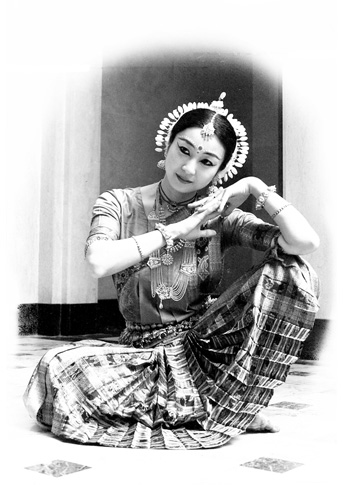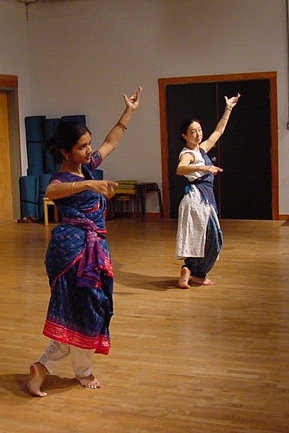 Editor’s Note: On November 3, 2007, San Francisco Bay Area Odissi dancer Asako Takami passed away after a four-year battle with ovarian cancer.
Editor’s Note: On November 3, 2007, San Francisco Bay Area Odissi dancer Asako Takami passed away after a four-year battle with ovarian cancer.
Takami was born in Nigata, Japan, and became involved in Odissi dance at the age of 20. She was a college student studying art and Japanese design when she was first exposed to Indian dance. At that time she began studying Kathakali and Manipuri, two of India’s classical dance forms. Later she saw a performance in Tokyo by legendary Odissi dancer Sanjukta Panigrahi and was profoundly moved by the performance. She told Hinduism Today in 2000, “I was very shocked that one human body can change the space and energy. I didn’t think I could do that with my body, but I wanted to. Right after this performance, I met my teacher, KumKum Lal, who was visiting Japan from India. I went to her place and said I wanted to study Odissi. She just started teaching in her kitchen. That’s how I began in 1983.” For seventeen years, Takami traveled to India for several months at a time, training with KumKum Lal in Delhi, and with Lal’s teacher, Guru Kelucharan Mohapatra, in Orissa, the home of Odissi dance. Takami is the founder and artistic director of the East Bay-based Pallavi Dance Group.
In 2005, Takami was a master artist in ACTA’s Apprenticeship Program with apprentice Chaitee Sengupta.
In March 2004, my Odissi dance teacher Asako Takami and I applied for ACTA’s Apprenticeship Program. The application asked, “Why do you want to work with this master artist?” My answer was, “Anyone who meets Asako knows that she is very reluctant to call herself a teacher or even think of herself as a teacher. To me though, she embodies so many qualities as both a person and a dancer that I admire and strive to emulate, which is why I sought her out as my teacher. Asako is such a beautiful, precise, and graceful dancer. Her knowledge and faithfulness to the traditional choreography is so detailed and conscientious. As a person and a dancer, Asako is so humble and unassuming and free from egotism or a competitive nature. In the world of dance this is a rare and precious type of person, especially to have as a teacher. She encourages all her students to experience the joy of dancing by freely sharing everything she can offer.”
Of her experience with Odissi, Asako told the Alliance, “For me dancing, performing and teaching Odissi dance is a form communication, a tool of connecting with people and with my deeper self. This dance form nourishes and cultivates my personal life and from that I deepen my practice.
“When I came to the US, everyone around me was talking about ‘identity.’ It made me think a great deal of my Odissi practice as a Japanese person. It was and is a creative conflict. When I dance, perform, study with my Indian teachers, I know my approach, my devotion, is different. Over the years I’ve slowly recognized that my approach is something already there, inside the form, an honesty, in how I can and must approach this foreign form. I always come back to this truth, that this strict form creates a pure, distinctive power, an energy which I feel with my particular body. It is not about being Oriyan or Indian or Japanese, it is about dancing, that humanness. I am outside of the culture that this dance is deeply rooted in. There is an inherent abstraction to my approach.”
 We found out early that summer that we were accepted into the Apprenticeship Program. We also found out that Asako had been diagnosed with cancer. That summer and fall she went through intense and difficult cancer treatments—surgery, radiation, chemotherapy. The treatment ravaged her body, but amazingly by spring she was well enough again to dance and teach, and we were able to work together through the apprenticeship. I was incredibly lucky to learn a beautiful abhinaya (expressive story telling) piece from her, called Sahki He, a traditional item in the Odissi repertoire from the Gita Govinda, a 12th century Sanskrit lyrical poem.
We found out early that summer that we were accepted into the Apprenticeship Program. We also found out that Asako had been diagnosed with cancer. That summer and fall she went through intense and difficult cancer treatments—surgery, radiation, chemotherapy. The treatment ravaged her body, but amazingly by spring she was well enough again to dance and teach, and we were able to work together through the apprenticeship. I was incredibly lucky to learn a beautiful abhinaya (expressive story telling) piece from her, called Sahki He, a traditional item in the Odissi repertoire from the Gita Govinda, a 12th century Sanskrit lyrical poem.
At the time I did not know that our work together in the Apprenticeship Program would be my last chance to study Odissi with Asako. Her cancer returned later that year. After another round of medical treatments and a long stretch of alternative healing efforts she passed away on November 3, 2007. She is survived by her parents, her sister, and her partner Ralph Lemon, as well as an international community of friends, students and people she has inspired. As her student and friend, I feel so proud and lucky to have had the opportunity to spend time with her and study dance with her.
In October I had the opportunity to meet KumKum Lal, Asako’s teacher, for the first time when she was visiting ailing Asako in San Francisco. She told me that of all her students, she only taught Sakhi He to Asako. How wonderful that Asako could pass this on to me. I thank the Alliance for making it possible.
